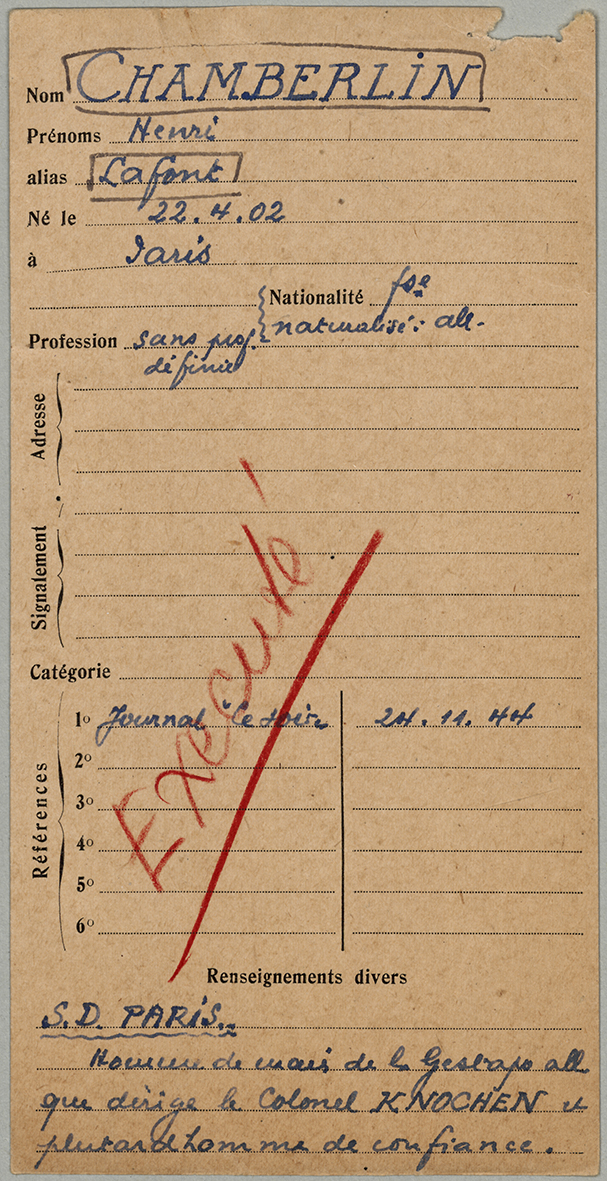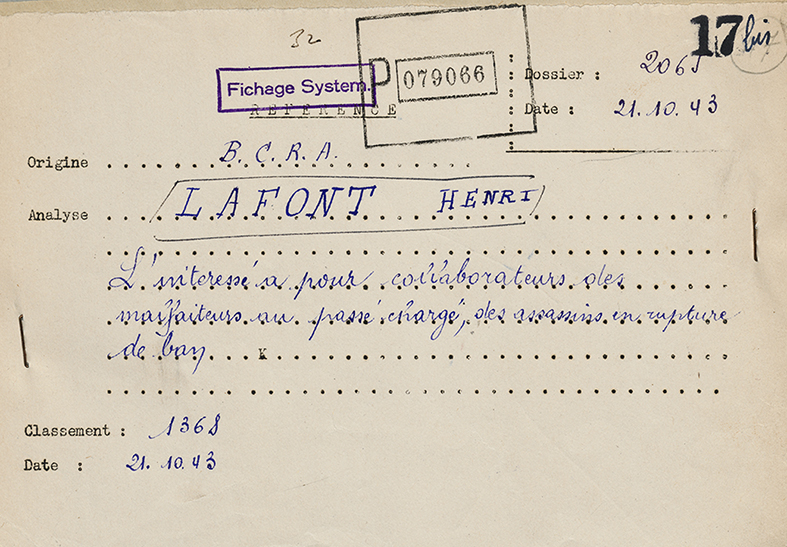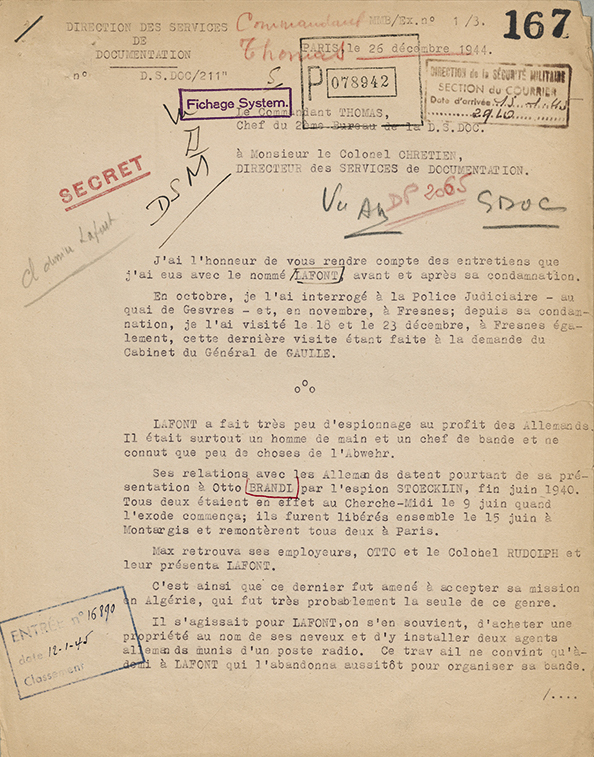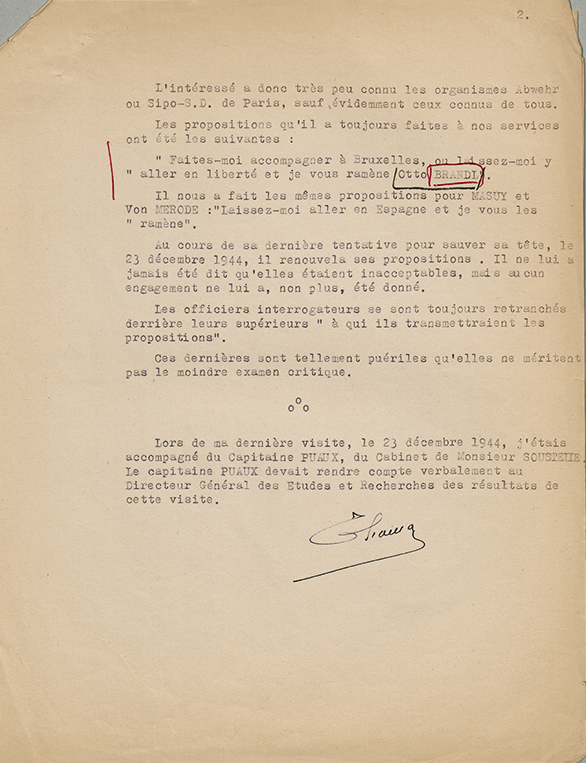A cart is ready

On 30 August 1944, Henri Chamberlin alias ”Henri Lafont” and several of his accomplices of the ”French Gestapo of Rue Lauriston” were arrested in Seine-et-Marne. The BCRA had been accumulating information on the man who had reigned over the Paris underworld during the Occupation for over three years. The file conserved by the SHD tells us much about the hidden aspects of the case, and sheds new light on the process that led to the execution of one of the most feared individuals of the period.
It was a curious file that the French special services gathered on Henri Chamberlin, alias Henri Lafont. No fewer than 700 pages, showing that the head of the formidable ”French Gestapo of Rue Lauriston”, also known as the ”Carlingue”, was closely watched and that his activities had caught the eye of the BCRA's agents.
From the underworld to the ”Gestapo”
Lafont deserved this attention. A petty criminal of no particular interest, this marginal figure suddenly became the chief of a German police service during the Occupation. From then on, the French forces of law and order could no longer touch him. For three years, at the head of a band consisting almost entirely of crooks and corrupt policemen, such as Pierre Bonny, he ran an operation with considerable economic importance: theft of Jewish assets, bogus police officers, large-scale racketeering and black-market trade, blackmail with threats of arrest and release in exchange for bribes, illegal seizures and burglaries, armed robbery, receiving stolen goods… But above all, the ”Carlingue” was a very active component in the German system of repression: arresting patriots, recovering supplies air-dropped by the Allies, discovering arms and munitions caches, attacks on resistance organisations such as Défense de la France, expeditions against the maquis in Dordogne and Limousin, torture and abuse of prisoners, murders…
Intelligence about Lafont and his team started to flow in August 1941. For three years, summaries, memos, official reports from the police services, cables sent to London and notices succeeded each other and expanded a file whose only purpose seems to have been to explain the inconceivable: how did a petty criminal manage to rise to this position?
In all, the file is an incredible compilation of intelligence, containing accurate information in the midst of a great many errors.
Facts and fallacies: the ”false news” of intelligence
Yes, Henri Lafont was a crook, convicted several times before the war for minor offences. Yes, he became the head of an official police service on behalf of the Occupation. Yes, Lafont's gang consisted of fearsome individuals, corrupt former policemen and underworld bosses (sees slideshow), whose colourful nicknames should not disguise how dangerous they were: ”Jean the Bald”, ”Robert the Pale”, ”André the Trough”, ”Jean the Showgirl”, ”Abel the Mammoth”, ”Michel Rednose”, ”Rosy Raymond”, ”Charlot the Feverish”, ”Paulo the Thinker”… Yes, Lafont was a powerful figure: he knew the highest-ranking Germans in Paris during the Occupation, he spent time with the head of the Vichy government, Pierre Laval, the secretary general of the police, René Bosquet, and the prefect of police, Amédée Bussière. Yes, he dined with ministers, prominent journalists, businessmen, German officials. Yes, the deals he arranged amounted to hundreds of millions of francs.
But no, Lafont did not reign over a team of 900: at its peak, in 1944, his gang had no more than 300 members. No, clearly Lafont was not close to Hitler, and there is nothing to suggest he met the future Führer during Hitler's incarceration at Landsberg am Lech prison in 1924. No, his service did not report directly to Himmler, but to a clearly identified hierarchical chain of command which evolved through its own administrative changes and reorganisations of the German services (Abwehr until May 1942, then SIPO-SD). Similarly, the man's own abilities and his role in the organisation of German repression should be seen in context.
From the ”Gestapo” to the firing squad
When the head of the ”Carlingue” was arrested on 30 August 1944 by the FFI (French Forces of the Interior) and agents from the special section of the Prefecture of Police led by Commissioner Clot, their trophy must have seemed impressive. The Direction générale des études et recherches (DGER, Directorate General of Studies and Research) immediately took an interest - perhaps he had useful information. The Service was keen to exploit what it considered ”a significant source of intelligence”. They must have been very disappointed: a zealous executor of horrific orders, Chamberlin had never been a decision-maker. For the head of the 2nd bureau of the documentation services directorate, the judgement seemed conclusive: ”The person concerned has very little knowledge of the Paris Abwehr or SIPO-SD, except obviously those known to everyone”. Chamberlin's efforts to save his skin were fruitless: commander Thomas considered them ”so childish that they do not deserve the slightest critical examination” (see slideshow).
By then, nothing could save the former Gestapo officer, especially as the press had given his arrest considerable coverage. On 4 October, a note from the Prefecture of Police announced that ”in eight days, M. Clot will be ready to delivery a first cart of twenty” to the justice system (see slideshow). Barely two months later, Chamberlin was condemned to death by the Seine Court of Justice and shot on 26 December 1944 at the Fort of Montrouge in Arcueil (see slideshow).
Grégory Auda
Editor of the magazine Les Chemins de la mémoire,
FOR MORE INFORMATION
The full file on Henri Chamberlin, numbered GR 28 P 9 883, can be consulted in the reading room.
The archives of the Paris Prefecture of Police also hold documents on the case.

Fiche de renseignements sur Henri Chamberlin, sans date.
© SHD

Note de renseignement sur le service de la rue Lauriston, 21 octobre 1943.
© SHD

Lettre du commandant Thomas au colonel Chrétien sur Henri Chamberlin, 26 décembre 1944, p. 1.
© SHD


